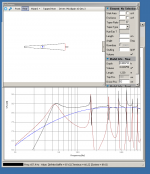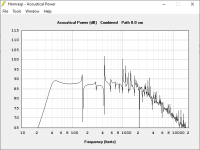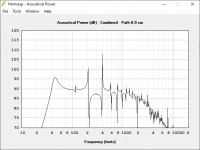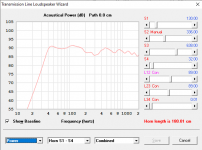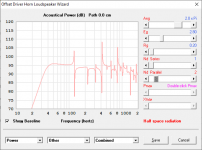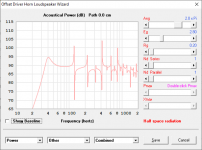...best price performance ratio is with 207 or 167 ...
Discontinued over a decade ago. FF225wk and FF165wk are closest, AudioNirvana is an aquired taste.
As birkie has done Mark Audio is a good choice and superb value. CHN-110 is an especially good speaker for little.
dave
If I accept 4mm excursion in the bass frequencies as a soft limit
Hmm, out from the wall there will be baffle step roll-off of up to 6 dB + ~12 dB to the LP + up to at least 15 dB transients [minus 3 dB for stereo] is starting to sound kind of anemic on average for big band and especially the better live jazz recordings, so either bigger and/or more powerful drivers and/or dedicated [mid] bass system [w/sub if no close by neighbors] seems appropriate.
Discontinued over a decade ago. FF225wk and FF165wk are closest, AudioNirvana is an aquired taste.
As birkie has done Mark Audio is a good choice and superb value. CHN-110 is an especially good speaker for little.
dave
Wow...CHN-110 is the right price and seems to be a good choice...
please direct me to the plans for CHN-110 and both FF you suggest!
And obiovsly 1000000000thanks for superfat suggestions!
EDIT:
I forgot to mention that I would combine them with a 1.5 watt tube amp in medium small room
I forgot to mention that I would combine them with a 1.5 watt tube amp in medium small room
Metronome is an idea, till this AM i don’t know if anyone has devised a Met for the CHN-110. Dr Scott got back to me, here is his suggestion.
If you want drawings email me.
dave
CHN110 metronome
L = 70in
St = 5 3/4in x 3 1/2in
Sm = 11in x 9in
Zd = 35in
Vd = 2 1/2in
Vl = 3/4in
Lag top & non-opposing walls 1in OC-703, SAE F10 or equivalent.
Fb = 37Hz
F6 = 31Hz [nominal anechoic]
If you want drawings email me.
dave
A contrary take: Maybe smaller?
I have a set of Metronome style speakers using the Alpair 10.3M driver that I dearly love. I initially built a much bigger pair about the same size as recommended above. They got cut apart and put in the trash bin in short order.
After I examined the Metronome table I decided to build a smaller pair and modeled in the Leonard Transmission Line software. The resulting build was much better but had a hole in the mid-base. Out came the saw and I cut nearly 4" off the top. Better. After a few weeks I again brought out the saw and cut another 4" off the top. Experimenting with port lengths everything snapped into place with a 4" tube. They have remained unchanged since then.
Top 2-3/4" by 4-3/4" Bottom 6-3/4" by 8-3/4" Line Length 45", Driver Position 20.5 Vent 4" by 1-7/8". Carpet pad from the driver up. Lightly stuffed. (My experience is that I end up removing most of the stuffing.)
Caveats: I have no expertise in speaker design, and the 10.3M is not a CHN-110.
Here is what Leonard Transmission Line thinks how the result should work with no stuffing.
-Tom-
I have a set of Metronome style speakers using the Alpair 10.3M driver that I dearly love. I initially built a much bigger pair about the same size as recommended above. They got cut apart and put in the trash bin in short order.
After I examined the Metronome table I decided to build a smaller pair and modeled in the Leonard Transmission Line software. The resulting build was much better but had a hole in the mid-base. Out came the saw and I cut nearly 4" off the top. Better. After a few weeks I again brought out the saw and cut another 4" off the top. Experimenting with port lengths everything snapped into place with a 4" tube. They have remained unchanged since then.
Top 2-3/4" by 4-3/4" Bottom 6-3/4" by 8-3/4" Line Length 45", Driver Position 20.5 Vent 4" by 1-7/8". Carpet pad from the driver up. Lightly stuffed. (My experience is that I end up removing most of the stuffing.)
Caveats: I have no expertise in speaker design, and the 10.3M is not a CHN-110.
Here is what Leonard Transmission Line thinks how the result should work with no stuffing.
-Tom-
Attachments
Last edited:
But the Pioneer, of restomodded to current standards, likely smokes the Sansui, and teh Alpai ris good enuff to show the differences.
Yeah, I replaced the coupling caps on it back in high school a little over 25 years ago (one of the 6BM8 finals was red-plating), and it was outstanding into headphones (I didn't have decent speakers at the time). It had the best phono stage I've ever heard. Life intervened, and it has been at least 15 years since I played it. I didn't replace the power supply or filter caps at the time, so it'd definitely need a bit of restoration, but I'd love to have it back in service.
Hmm, out from the wall there will be baffle step roll-off of up to 6 dB + ~12 dB to the LP + up to at least 15 dB transients [minus 3 dB for stereo] is starting to sound kind of anemic on average for big band and especially the better live jazz recordings, so either bigger and/or more powerful drivers and/or dedicated [mid] bass system [w/sub if no close by neighbors] seems appropriate.
How about if I were to re-locate it against a wall, and/or go with a bipole configuration? If I'm reading things right in hornresp models, a bipole could do about 103dB @ 1m @ 4mm excursion into half-space. Re-locating the speakers against a wall (quarter space) and using only one driver also gives a max SPL of 103dB @ 1m @ 4mm excursion. I can use the Pioneer with that setup, though its 11-ish watts will only buy about 98dB or so.
Dunno. I've never had a decent pair of speakers, a decent space, and adequate time before, so I'm fairly new to this whole thing. My wife absolutely adores the look of the metronome speakers. My gut instinct tells me to just go ahead and build a pair of single-driver metronomes using one of the markaudio drivers, play around, and try things out.
I replaced the coupling caps on it back in high school a little over 25 years ago
Gien a 1-20 year lifespan time to do it again, but it is the elcos that will need it most. Usually with an amp that old all the caps have to be replaced.
dave
Stupid question: For the bipolar metronome variants using 8-ohm drivers and a tube amp, would it be possible to wire the drivers in series and use the 16-ohm tap from the amplifier? I've only seen parallel + 4-ohm tap discussed in the threads. The net result of each configuration would be the same watts to the speaker and same volume setting on the amp, just different voltages and currents under the hood ... right? Or am I missing something?
There is just as much variety in tube amps as solid state amps. You will have to be more specific.
Now, most tube amps have output transformers with some variety of 4, 8, 16 ohm taps. What taps does yours have?
My advice is try it both ways, with all the taps and use the one where the amplifier seems happiest (sounds best).
dave
Now, most tube amps have output transformers with some variety of 4, 8, 16 ohm taps. What taps does yours have?
My advice is try it both ways, with all the taps and use the one where the amplifier seems happiest (sounds best).
dave
There is just as much variety in tube amps as solid state amps. You will have to be more specific.
Now, most tube amps have output transformers with some variety of 4, 8, 16 ohm taps. What taps does yours have?
So, my (tube-based) Pioneer has 8 and 16 ohm taps only. Given that no 4-ohm tap exists, I'm wondering if wiring the drivers in series (then attaching the speaker to the 16-ohm tap) could potentially be the best way of driving a bipolar metronome with that kind of amplifier.
As a corollary, suppose I had 4, 8, and 16-ohm taps. Is there any reason a priori to prefer parallel drivers (4-ohm load) as opposed to series (16-ohm)?
The higher the tap, the lower the current draw = normally better overall. Parallel halves inductance, series doubles it, so with low DF amps, if a driver has a rolled off HF the increased inductance will lift it up or minimize a rising response if in parallel and of course similar happens down around tuning, which historically is driver Fs to maximize bass response.
Line Length 45", Driver Position 20.5 Vent 4" by 1-7/8". Carpet pad from the driver up. Lightly stuffed. (My experience is that I end up removing most of the stuffing.)
Thanks for sharing! My kind of DIY problem solving. You effectively lowered the driver in the pipe and had you dropped it another 2" to the 50% point would have optimized it even more, though only a little less stuffing required, so of course no big deal. 😉
After I examined the Metronome table I decided to build a smaller pair and modeled in the Leonard Transmission Line software. The resulting build was much better but had a hole in the mid-base. Out came the saw and I cut nearly 4" off the top. Better. After a few weeks I again brought out the saw and cut another 4" off the top. Experimenting with port lengths everything snapped into place with a 4" tube. They have remained unchanged since then.
Top 2-3/4" by 4-3/4" Bottom 6-3/4" by 8-3/4" Line Length 45", Driver Position 20.5 Vent 4" by 1-7/8". Carpet pad from the driver up. Lightly stuffed. (My experience is that I end up removing most of the stuffing.)
I entered those numbers into hornresp, and the resulting graph largely agrees with yours. Interestingly, the "saddle" (low spike followed by a broad dip before the resonance peaks set in) is shallower in your design when compared to several of the designs in the metronome alignment table with their native drivers. I'm not sure if that has any bearing on sound quality or not, but from my noodling around in hornresp, best I can tell is that both can result in nice looking curves when stuffed, though the flatter saddle tends to require less stuffing.
Attached are hornresp results (stuffed and unstuffed) if your 10.3 design, and the suggested CHN110 design
Attachments
Last edited:
So, my (tube-based) Pioneer has 8 and 16 ohm taps only.
Then yes, you are most likely be best wiring in series. It is worth noting that all the original drivers used in microTower were 4 ohm and wired in series.
dave
110 box as indicated by Dave above. I've backed off the lagging as everybody seems to prefer them with less.
Depending on placement, they may, or may not require a shelving filter. I would suggest trying without initially: the 110 has an anechoic response with a slightly elevated LF region that should compensate for at least a proportion of step-loss in practice. If it still needs a bit more, so be it, and that would be the time to apply, as you'll have a better handle on what it's doing in practice & how much you'll need. Just don't slap a generic -6dB shelving on them from the outset, because if they're anywhere near boundaries, they'll likely end up bass heavy.
Not that I have any objection to a bit of LF.
Depending on placement, they may, or may not require a shelving filter. I would suggest trying without initially: the 110 has an anechoic response with a slightly elevated LF region that should compensate for at least a proportion of step-loss in practice. If it still needs a bit more, so be it, and that would be the time to apply, as you'll have a better handle on what it's doing in practice & how much you'll need. Just don't slap a generic -6dB shelving on them from the outset, because if they're anywhere near boundaries, they'll likely end up bass heavy.
Not that I have any objection to a bit of LF.

Attachments
How about if I were to re-locate it against a wall, and/or go with a bipole configuration?
You could of course, but the Metronome's shape makes for an uneven loading, so bi-pole is the better overall choice.
I've been playing around with hornresp, and I think I stumbled upon a design that works well as a monopole or bipole with the chn110 driver. This started out as tweaking the design scottmoose posted for a single-driver CHN-110 so that it would support two drivers in bipole config. I'm not sure if it's a general property of metronome speakers that bipole dimensions also are suitable for single drivers, but here it is
[FONT=Verdana, Helvetica, Arial]So: 64 cm2 (10 sq in)
Sl: 900 cm2 (140 sq in)
[/FONT]
[FONT=Verdana, Helvetica, Arial]L: 168 cm (66 in)
Zd: 84 cm (33 in)
[/FONT]
[FONT=Verdana, Helvetica, Arial]Port diameter: 10.3 cm (4 in)
Port length: 14.5 cm (5 3/4 in)
[/FONT]
Overall volume is just a tiny bit higher than scottmoose's single-driver design, which gives me pause that I could be doing something wrong. (i.e. are any of the dimensions impractical/problematic/suboptimal in real life?) The single-speaker variant needs a little stuffing in the bottom portion to smooth out the initial peak near Fb, but looks good once that's done. I've attached hornresp graphs of stuffed bipole vs monopole, and the raw response of each. I've also attached a pdf of a scale drawing
Interestingly, I tried the same design with the CHR-90, and the results are almost identical to the CHN-110. The biggest difference in the model is the CHN-110 requires a little less cone displacement to reach the same SPL when compared to the CHR-90. Otherwise, they practically behave identically.
[FONT=Verdana, Helvetica, Arial]So: 64 cm2 (10 sq in)
Sl: 900 cm2 (140 sq in)
[/FONT]
[FONT=Verdana, Helvetica, Arial]L: 168 cm (66 in)
Zd: 84 cm (33 in)
[/FONT]
[FONT=Verdana, Helvetica, Arial]Port diameter: 10.3 cm (4 in)
Port length: 14.5 cm (5 3/4 in)
[/FONT]
Overall volume is just a tiny bit higher than scottmoose's single-driver design, which gives me pause that I could be doing something wrong. (i.e. are any of the dimensions impractical/problematic/suboptimal in real life?) The single-speaker variant needs a little stuffing in the bottom portion to smooth out the initial peak near Fb, but looks good once that's done. I've attached hornresp graphs of stuffed bipole vs monopole, and the raw response of each. I've also attached a pdf of a scale drawing
Interestingly, I tried the same design with the CHR-90, and the results are almost identical to the CHN-110. The biggest difference in the model is the CHN-110 requires a little less cone displacement to reach the same SPL when compared to the CHR-90. Otherwise, they practically behave identically.
Attachments
- Home
- Loudspeakers
- Full Range
- The Metronome
